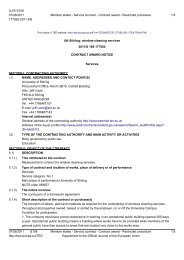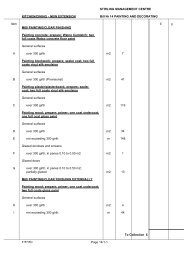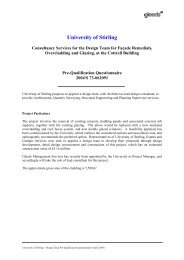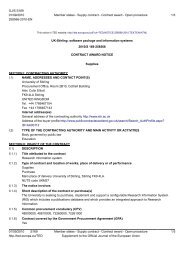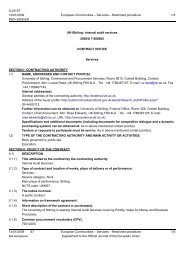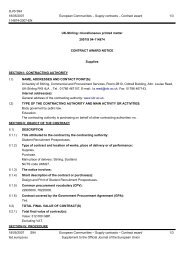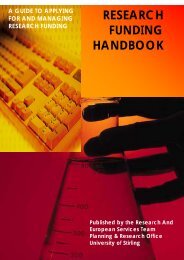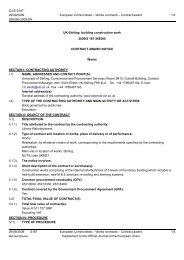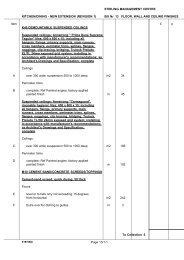estate strategy 2007-2017 - Publication Scheme - University of Stirling
estate strategy 2007-2017 - Publication Scheme - University of Stirling
estate strategy 2007-2017 - Publication Scheme - University of Stirling
- No tags were found...
You also want an ePaper? Increase the reach of your titles
YUMPU automatically turns print PDFs into web optimized ePapers that Google loves.
where are we now: the existing <strong>estate</strong>Senior Deputy Principal (Academic Operations), hasbeen established to investigate methods <strong>of</strong> furtherincreasing the utilisation <strong>of</strong> teaching space. Thebenefits <strong>of</strong> improved utilisation are well recognisedand calculations using the Space ManagementGroup’s 4 efficiency multiplier have indicated thatimprovements in this area should be achievable andcould potentially release space for alternative uses.Significant refurbishment <strong>of</strong> teaching space hasbeen undertaken in recent years to ensure thefacilities can support changing technologies andmethods <strong>of</strong> teaching. The nature and extent <strong>of</strong> thework undertaken has been influenced and guidedby the <strong>University</strong>’s Learning Spaces Group whichwas established to advise on best practice in thedesign <strong>of</strong> learning spaces across the campus. Thegroup draws it membership from the academiccommunity and relevant service departments,and is advised by best practice reports on LearningSpaces such as those produced by Alexi MarmottAssociates and JISC. In addition, laboratory spacewas rationalised and reconfigured when theSchool <strong>of</strong> Biological and Environmental Scienceswas established.11.3 Use <strong>of</strong> Space Management Group metricsThe overall <strong>University</strong> <strong>estate</strong> has been benchmarkedagainst the Space Management Group (SMG) Model<strong>of</strong> the Affordable Estate to measure actual spaceagainst predicted space for an institution <strong>of</strong> the<strong>University</strong>’s size. The areas are based on the 2005/06Estate Management Statistics returns and results areshown in Table 11 below.Table 11: Comparison <strong>of</strong> <strong>estate</strong> size to SMG model predictionsActual(incl. specialistareas)Actual(excl.specialistareas)Predicted(utilisingcurrent spacetools)Predicted(utilising allavailablespace tools)Predicted(average<strong>of</strong> top 25%HEI’s)Total Non-Res Estate 65,220 48,101 60,350 54,667 38,595Core Teaching 10,035 10,035 17,187 15,951 9,774Teaching Offices 5,795 5,795 6,112 6,112 4,088Research 10,121 10,121 11,734 11,734 9,541Library 6,544 6,544 8,607 8,607 6,638Other Support 23,079 5,960 10,648 10,648 5,141Whilst the initial results appear to suggest thecurrent <strong>estate</strong> is larger than expected, this can beaccounted for by the high proportion <strong>of</strong> specialistfacilities on the campus including the <strong>Stirling</strong>Management Centre, shops, Macrobert ArtsCentre, and specialist sports facilities includingthe National Tennis Centre and Robertson TrustSwimming Pool. If these specialist facilities areremoved from the areas, the size <strong>of</strong> the <strong>University</strong><strong>estate</strong> places it close to the top 25% <strong>of</strong> institutionsin space efficiency terms.Whilst changes in teaching methods over theyears have resulted in an element <strong>of</strong> bad fit, themajority <strong>of</strong> the space remains appropriate for the<strong>University</strong>’s requirements. Indeed the fact that the<strong>University</strong>’s academic activities are almost entirelyhoused in two large buildings is advantageousand enables efficient adjustment <strong>of</strong> space arisingfrom the expansion and contraction <strong>of</strong> individualdepartments. The <strong>University</strong> does however suffera number <strong>of</strong> problems in relation to the suitability<strong>of</strong> its buildings. Pathfoot and Cottrell Buildingsare designed on a modular basis which does notreadily adapt to provide the size <strong>of</strong> rooms that maysuit the <strong>University</strong>’s future needs, particularly largerrooms and shared spaces. This also applies to <strong>of</strong>ficespace where academic <strong>of</strong>fices in the Cottrell andPathfoot Buildings were originally designed toallow small group teaching. This teaching modehas reduced considerably due to the financialpressures which have meant that staff/student4The UK Higher Education Space Management Group (SMG) and Space Management Project (SMP) is supported by the four UK funding bodies for highereducation.32




